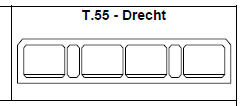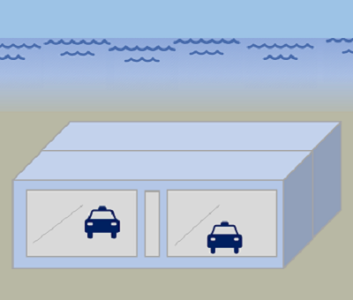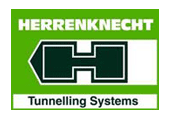Drecht Tunnel
HEIGHT: 8.08 m
WIDTH: 49.04 m
TOTAL IMMERSED LENGTH: 347 m
DEPTH AT BOTTOM OF STRUCTURE: 15 m
ENVIRONMENTAL CONDITIONS: River currents.
FABRICATION METHOD: At casting yard at Barendrecht (used previously for the Heinenoord and some pipeline tunnels), 12 km from site.
WIDTH: 49.04 m
TOTAL IMMERSED LENGTH: 347 m
DEPTH AT BOTTOM OF STRUCTURE: 15 m
ENVIRONMENTAL CONDITIONS: River currents.
FABRICATION METHOD: At casting yard at Barendrecht (used previously for the Heinenoord and some pipeline tunnels), 12 km from site.
Dordrecht,
Netherlands

Kombinatie Tunnelbouw: Dirk Verstoep BV, Van Hattem en Blankevoort and Koninklijke Nederhorst Bouw BV
Rijkswaterstaat, Directive Sluizen en Stuwen
115m
347m
15m
Project construction
1977-04-30
3
Four tubes; two lanes in each tube
8.08m
49.04m
Widest element ever constructed. Displacement 45,000 MT. Approach structures are of
a very unusual construction, utilizing drained slabs and top-down construction, with
slurry walls carried to clay. Tunnel elements were attached to end structures already in
place - on one end of tunnel, using a Gina joint; and on the other, using a gasketted
plate joint system. Two-lane spans were used to reduce depth of elements. Sand-flow
method was used for second time.
a very unusual construction, utilizing drained slabs and top-down construction, with
slurry walls carried to clay. Tunnel elements were attached to end structures already in
place - on one end of tunnel, using a Gina joint; and on the other, using a gasketted
plate joint system. Two-lane spans were used to reduce depth of elements. Sand-flow
method was used for second time.
At casting yard at Barendrecht (used previously for the
Heinenoord and some pipeline tunnels), 12 km from site.
Heinenoord and some pipeline tunnels), 12 km from site.
River currents.
Model tests were used to determine the number of tugs required to handle the segment.
The tests indicated 5,000 to 6,000 HP; however, 11,000 HP eventually were provided
for safety. Clearances for towing were very restricted, and an elaborate electronic
horizontal control method was implemented to keep elements from running aground.
Element blocked 40% of river at times during towing.
Transverse pontoons with two control/alignment towers were used for placement. Fourpoint
support was used at placement because of the width of the section. Vertical and
horizontal jacks were used for adjustment of alignment.
The tests indicated 5,000 to 6,000 HP; however, 11,000 HP eventually were provided
for safety. Clearances for towing were very restricted, and an elaborate electronic
horizontal control method was implemented to keep elements from running aground.
Element blocked 40% of river at times during towing.
Transverse pontoons with two control/alignment towers were used for placement. Fourpoint
support was used at placement because of the width of the section. Vertical and
horizontal jacks were used for adjustment of alignment.
Gina type joints
Membrane waterproofing was used because of the great width of the tunnel. The
elements were divided into six subsections with temporary prestress, which was cut
after backfilling.
elements were divided into six subsections with temporary prestress, which was cut
after backfilling.
The sand-flow method used on the Vlake tunnel was repeated for this tunnel.
Reinforced














